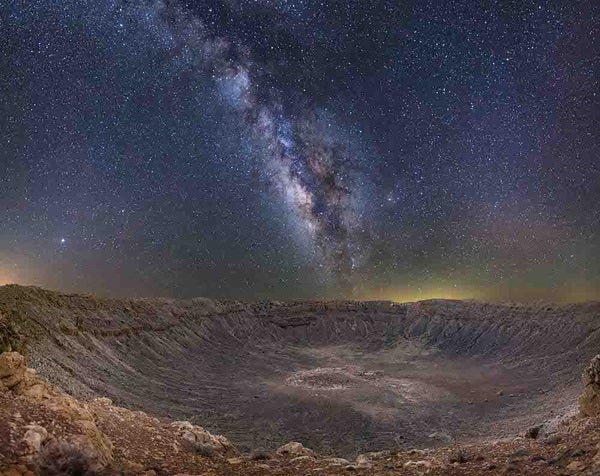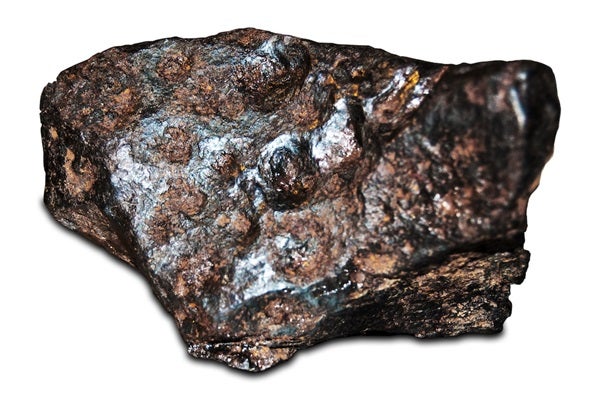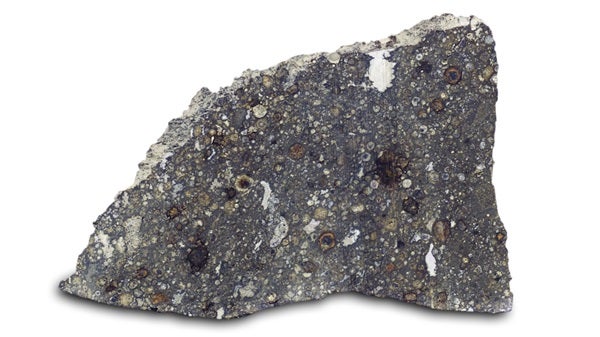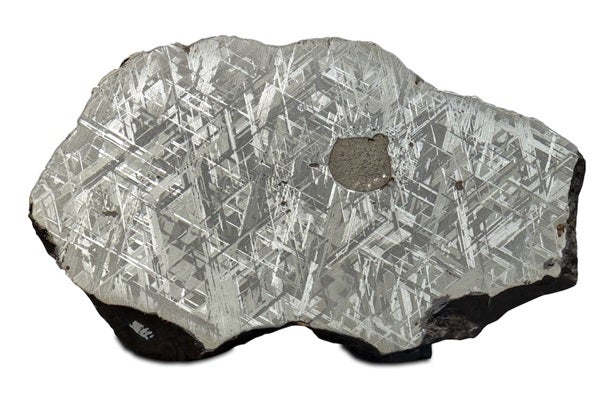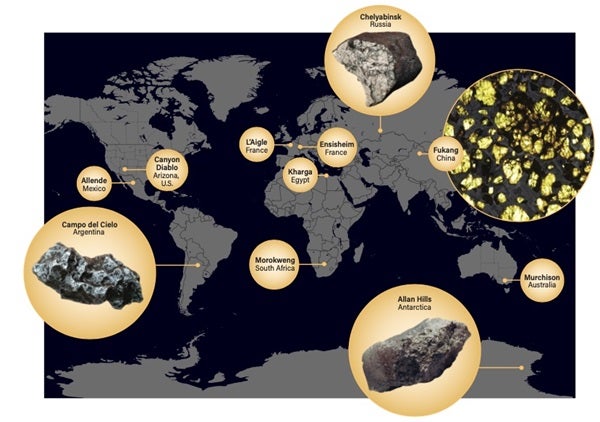In July 1969, the crew of the Apollo 11 brought back nearly 48 pounds (22 kilograms) of pristine lunar rocks from the most incredible — and expensive — rock-collecting expedition in history. NASA had state-of-the-art clean laboratories and equipment ready to analyze these samples in unbelievable detail.
In the same year, however, nature also provided several tons of cosmic debris for free.
In February 1969, a massive meteorite rained a couple of tons of stones on the Mexican town of Allende, not far from the Texas border. And in September, over 200 pounds (90 kg) of cosmic material fell near the town of Murchison in Victoria, Australia, about 100 miles (160 kilometers) north of Melbourne.
The timing of these events was perfect. Geologists, chemists, and other scientists were better prepared to coax secrets from these otherworldly rocks than at any other time in history. For most of human history, the origin of these stones was an enigma. But by the mid-20th century, there was no doubt that these rocks had a cosmic origin. The bits of detritus that found their way to Earth in 1969 marked a milestone in our quest to unlock their mysteries.
Early visitors
Humans have seen rocks falling from the sky for thousands of years. One of the earliest potential recorded accounts dates to 1478 b.c., when, according to the Parian Chronicle, a “thunderstone” fell on the island of Crete. In 465 b.c., the Greek poet Pindar saw a meteorite land not far from the hill where he was sitting. And in 1492, a stone fell from the sky just outside the city of Ensisheim, France, becoming a marvel in Europe for centuries. It was widely believed that these stones formed in clouds and, when heavy enough, simply fell to Earth. Where else could these ordinary-looking rocks have originated?
But at the start of the 19th century, a number of events came together that changed the way people understood and studied these objects. On April 26, 1803, the villagers of L’Aigle, France, saw and heard an amazing fall. Over 3,000 stones were recovered, making the event impossible to ignore. Just two years earlier, the astronomer Giuseppe Piazzi had discovered the asteroid Ceres, clearly showing that there were objects other than planets circling the Sun. Geologists and chemists also were making great strides in understanding terrestrial rocks and developing techniques to reveal their structure.
Around the year 1800, the British chemist Edward Charles Howard acquired several suspected meteorites, including examples of each of the three main meteorite types recognized today: stony, iron, and stony-iron. Howard was the first to dissect and subject these extraterrestrial stones to chemical analysis. In 1802, he reported that all three types of meteorites had a high level of nickel, a composition unlike anything seen before in terrestrial rocks.
Two years later, a British mineralogist, William Thomson, tried polishing an iron meteorite with nitric acid, revealing a striking crystalline pattern. These became known as Widmanstätten lines after Count Alois von Beckh Widmanstätten, who made a similar discovery in 1808. No such pattern is seen in iron mined on Earth. These two men had discovered the ancient frozen crystal structure of iron meteorites, unchanged for billions of years.
Leaping forward to the 20th and 21st century, meteorite research progressed thanks to new techniques and equipment used to study these cosmic visitors. These investigations included, unexpectedly, an archaeological mystery. In 1911, British archaeologist Gerald Avery Wainwright discovered necklace beads made of iron in a 5,500-year-old Egyptian cemetery in Gerzeh, about 44 miles (70 km) south of modern Cairo. And when the British archaeologist Howard Carter opened the tomb of the pharaoh Tutankhamun in 1922, he found — among many beautiful artifacts — a magnificent ceremonial dagger with a gold handle and an iron blade.
The presence of these iron artifacts was conspicuous, since during Tutankhamun’s life 3,300 years earlier, Egyptians had not yet mastered the art of smelting iron and were still using bronze for their weapons. Chemical tests indicated a high level of nickel in the Gerzeh beads and Tutankhamun’s blade, pointing to an extraterrestrial origin. However, in the 1980s, some archaeo-metallurgists suggested that nickel-rich iron ores found on Earth could have been the source of these artifacts.
Finally, in 2016, researchers reported in Meteoritics and Planetary Science a noninvasive examination of King Tutankhamun’s iron dagger that confirmed its meteoritic origins. The team used a portable X-ray fluorescence spectrometer, which looks at the wavelengths of fluorescing elements to determine their abundance. The researchers found the dagger was nearly 11 percent nickel and around 0.6 percent cobalt — whereas terrestrial iron produced before the 19th century rarely exceeds 4 percent nickel. They then compared this to iron meteorites found within a 1,200-mile (1,930 km) radius of Tutankhamun’s tomb and found a possible match — the Kharga meteorite, found in 2000 near the city of Marsa Matruh, Egypt. Using similar tests, the Gerzeh beads were shown in 2013 to be from an iron meteorite.
Digging in
One of the primary devices used to study meteorites is the mass spectrometer. This instrument can detect atoms of specific elements and measure the abundance of their isotopes — atoms of the same element with the same number of protons but with differing numbers of neutrons. Measuring the abundances of various isotopes can be used to date samples. For example, carbon-14 is widely used to determine the age of organic material. Isotope analysis can also be used to dissect and study the atomic components of meteorites.
There is a downside: The sample is destroyed in the process. To probe a sample with a mass spectrometer, a small piece of meteorite is placed in a chamber, where it is heated until it vaporizes. The gas is then ionized, and the resulting ions are accelerated with an electric or magnetic field. Since different isotopes have different masses, they are deflected by differing amounts, indicating their relative abundance. This technique can be used to reveal some of the secrets locked up in meteorites.
The massive fireball that exploded over Allende in February 1969 provided plenty of material, scattering thousands of stones over a huge area. Over 2 tons were recovered, giving researchers — already primed by the impending Apollo missions — an abundance of material to investigate. As a result, the Allende meteorite has become one of the most studied meteorites in history.
The Allende meteorite is a rare primitive meteorite known as a carbonaceous chondrite. It is rich in carbon in the form of graphite, organic compounds, water, and amino acids. When sliced open, its interior is black and filled with beautiful white, snowflakelike inclusions. When analyzed with a mass spectrometer, these white specks were found to be the oldest known minerals in the solar system, an estimated 4.567 billion years. The calcium-aluminum materials had to form out of material from the nebula that birthed the Sun, and at extremely high temperatures that could only be found in the early solar system. Studies using mass spectrometers also showed oxygen isotopes similar to those found in the Sun. The Allende meteorite is now considered one of the oldest objects ever found on Earth.
When the Murchison meteorite fell just two months after Apollo 11 returned from the Moon, researchers had yet another unusual carbonaceous chondrite meteorite to study. Like the Allende meteorite, the Murchison is made of a kind of cosmic gravel called chondrules, which coalesced in the earliest stage of the solar system’s birth.
Researchers are now tracing this story even further back in time by identifying and studying presolar grains of dust — cosmic specks locked in the meteorites that formed even before the Sun did. A 2020 study in Proceedings of the National Academy of Sciences reported presolar silicon carbide particles in the Murchison meteorite — remnants of stardust up to 7 billion years old!
A 2020 study in Physical Review Letters offers the potential to learn more about presolar grains. The team, led by researchers at the University of Surrey, England, developed a technique using a linear particle accelerator at Argonne National Laboratory in Illinois to trace the paths of gamma rays emitted by reactions involving the isotope argon-34. Using this data, the team calculated the ratios of sulfur isotopes produced in two types of stellar explosions: supernovae, the explosive deaths of aging stars; and novae, thermodynamic explosions of material limited to a star’s outer layer. The results could allow scientists to determine whether a particular presolar grain was formed in a supernova or a nova — providing information about the death of stars in the vicinity of our solar system long before it began to form.
The age of Earth
None of this information has context without one precise indicator: knowing the age of Earth. From ancient Greek philosophers to 21st-century scientists, humans have always sought to measure the age of our world.
Researchers obtained one key to this mystery during the Manhattan Project, the U.S. research program that unlocked the destructive power of the nuclear bomb. As part of this work, scientists determined the rate of decay for uranium with great precision.
Among the uranium isotopes that naturally occur on Earth are uranium-238 and uranium-235. Both decay into two different isotopes of lead, though at different rates. But trying to measure the abundance of lead isotopes on Earth to find its age does not give a correct answer. It turns out that not all lead on Earth came from decaying uranium. To solve this problem, scientists needed to know how much of each lead isotope existed when the solar system formed — and a meteorite provided the answer.
In 1948, Clair Cameron Patterson, a Ph.D. student at the University of Chicago, was tasked with investigating the lead concentrations of meteorites. His supervisor, geochemist Harrison Brown, reasoned that iron meteorites would have formed with nearly no uranium, meaning their ratio of lead isotopes would reflect that in the early solar system. Patterson sliced his samples open and found pockets of sulfides, from which he extracted a tiny sample of lead.
But when he tried to measure the lead, he ran into an almost insurmountable roadblock: lead contamination. His dusty laboratory in Kent Hall — one of the oldest buildings on campus — was filled with lead. It was in the solvents he used to dissolve the sample, in the glass flasks he was using, on his hands, and in the air.
It wasn’t until Brown accepted a faculty position at Caltech — and took Patterson with him — that Patterson had the funding to build from scratch what was then one of the cleanest laboratories in the world. In 1953, he was finally able to extract a pure sample of primordial lead from a small chunk of the iron Canyon Diablo meteorite, which fell about 60,000 years ago and created the famous Meteor Crater in Arizona. He then vaporized his sample in a mass spectrometer at Argonne and measured the exact ratios of isotopes to find his answer: Earth is 4.55 billion years old.
Patterson’s work had far-reaching consequences. He went on to champion the reduction of lead in our environment, most notably in leaded gasoline. And as result of Patterson’s efforts, cleanroom laboratory technology was ready for NASA when Moon rocks were brought to Earth. And all of this came about because of a meteorite.
The effort to extract knowledge from these bits of cosmic detritus is far from over. The search is now on for fossilized micrometeorites — rocks that fell to Earth millions of years ago and are now preserved in ancient limestone. (See “Excavating cosmic fossils” in the August 2020 issue for more.) When meteorites streak through the atmosphere, they absorb oxygen. By analyzing these fossilized remains, we can get a glimpse of the ancient atmosphere and how it may have affected life on Earth.
From iron crystals to amino acids and ancient stardust, the study of meteorites has unlocked many tantalizing secrets. The work will continue, and more secrets will be discovered in these celestial visitors.
Cosmic visitors
Meteorite falls have been recorded throughout human history, yielding wonder, confusion – and knowledge. Here are just a few recovered space rocks that have proven historically or scientifically significant.
Allende (1969)
With over 2 tons of material recovered, this meteorite is one of the best studied in history.
Murchison (1969)
In 2020, scientists reported that this meteorite contains grains that are older than the Sun.
Ensisheim (1492)
The main mass of this meteorite is on display in the city’s Regency Museum.
L’Aigle (1803)
The L’Aigle meteorite was pivotal in establishing the extraterrestrial origin of such stones.
Canyon Diablo (60,000 years ago)
Clair Cameron Patterson used samples from this meteorite to determine the age of the Earth.
Kharga (impact date unknown, discovered 2000)
King Tutankhamen’s iron dag- ger may have been made from a fragment of this meteorite.
Morokweng (impact 145 million years ago, fragment found 2004)
Researchers drilling into the 44-mile-wide (70 kilometers) Morokweng impact crater in 2004 unexpectedly found a soccer-ball-sized chunk of the original asteroid. Previously, scientists had thought that large impactors would mostly vaporize on impact.
Allan Hills 84001 (impact date unknown, discovered 1984)
Recovered from the Allan Hills of Antarctica, this rock was originally a chunk of Mars. It achieved notoriety in 1996 when a team of researchers argued some features could be the remnants of fossilized microbial life — a claim ultimately rejected by most astrobiologists. NASA/JSC
Chelyabinsk (2013)
The 66-foot-wide (20 meters) asteroid that exploded over Chelyabinsk, Russia, in 2013 was the largest known object to enter Earth’s atmosphere since the Tunguska event in 1908. Svend Buhl/Meteorite Recon/CC BY-SA 3.0
Fukang (impact date unknown; discovered 2000)
Found by a hiker, the Fukang meteorite is considered one of the most beautiful ever found. When cut into slices, embedded fragments of olivine transmit light like a golden stained-glass mosaic. Wolfgang Sauber/CC BY-SA 3.0
Campo Del Cielo (impact 4,500 years ago)
The fireball and impact of this large meteorite — one fragment weighs 37 tons — may have been witnessed by Aboriginal people and transmitted as oral historical knowledge. In 1576, Argentinian authorities documented a fragment after investigating reports of locals wielding iron weapons forged from stones that had fallen in an area they called the Field of the Sky. Howardites Meteorites/CC BY-SA 4.0

